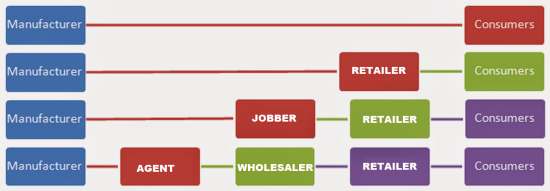Types of Channels of Distribution
Table of Contents
Types of channels of distribution
Channels of distribution are of various types such as Through Jobbers, Direct to consumer, Direct to retailers, through brokers or agents etc., as discussed below.
1. Through Jobbers as a distribution channel:
Through Jobbers is perhaps the oldest and widely used channel of distribution. Under this system, a jobber assembles products from a variety of producers, stores them and sells them to retailers. In doing so, he assumes the risk of a price rise or price fall and of product obsolescence. He provides credit facilities to retailers and sells the product to retailers on the basis of their requirements.
All these functions are essential in the distribution system, regardless of the channel of distribution used. When a large number of purchases come from retailers distributed over a wide territory, it is more desirable for the manufacturer to enlist the services of a wholesaler
than to undertake such activities himself. Lower-order shopping and convenience goods are generally sold in this manner.
2. Direct to Consumer channel of distribution:
In direct to consumer distribution channel, there is no intermediary. Sales are directly made to consumer either by producers, or house to house visits of salesmen. This channel is largely utilized when the product is of such nature that technical expertise is required in connection with its sale and after its sale. For example, this channel is utilized by producers of computers, ripographers and industrial machinery.
Secondly, producers of a variety of consumer goods employ direct to consumer channel of distribution to a certain extent. For example, producers of medicines, cosmetics, ready-to-wear clothes, furniture and, at times, publishers use this method. The producers of consumer goods utilizing this method often advertise that a variety of expenses made by various intermediaries are totally eliminated and that the selling company bears all the costs of distribution. But for consumer goods direct to consumer channel of distribution is not very desirable or economical.
3. Direct to Retailers channel of distribution:
Direct to retailers distribution channel by the producer direct to the retailers has some distinct advantages. By utilizing this method, he can put in a more aggressive sale effort to boost the sales of its products. This method also enables the producer to have first-hand information about the market and consumer’s interests.
Benefits of direct to retailers distribution channel:
By utilizing direct to retailers distribution method, the producer an exercise direct control over the final sale and establish a better relationship with retailers, a fact which plays a vital role in gearing up the sales for he is not dependent on an intermediary. He is also in a better position to influence price, promotional aids and other factors which have a direct bearing on the sales and goodwill of the organization.
Some companies that manufacture a variety of products set up their own sales branches which, in many ways, perform the functions of jobbers, i.e., they sell goods directly to retailers. The distributor may also have a place in the retail shops of the manufacturer like in the case of Bata Shoe Company or Bombay Dyeing Mills. Under this system, the manufacture is always in touch with trends in demands and consumer attitudes towards his products. But direct to retailers channel of distribution can only be profitably used by large manufacturers.
4. Through Brokers or Agents as channel of distribution:
In contrast to the jobber, a broker usually sells one type of product or a few closely-related products. Agents are largely employed for the distribution of producer’s goods, though they may also be utilized for the distribution of consumer goods. For example, he can be extensively used for the sale of electronic goods, agricultural goods, farm machinery, fruits and vegetables, etc. This channel of distribution is largely utilized by small manufacturers with a limited product line who sell in a widely dispersed market.


